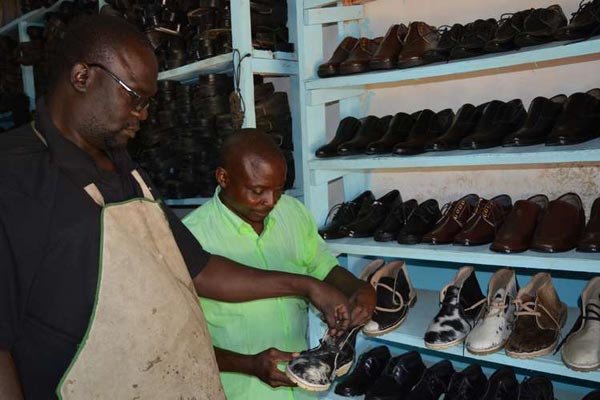Rabbit business in Kenya: The Kenya Industrial Estates in Kakamega town is a busy complex. It hosts all manner of small businesses run by several artisans. Here, you will find fashion designers and metal and furniture workshops.
It is in this complex, located along the busy Kakamega-Webuye road, that George Otieno has constructed his Maguna Shoe Craft mini-factory, where he makes footwear from rabbit, goat, cow and sheep skins.
However, of all the products, those made from rabbit skin are his forte. Otieno has employed eight young people whose work involves designing new shoe patterns while others cut the leather according the size. He has been in the shoes business for close to two decades, but he only ventured into the leather business two years ago.
Rising from a cobbler to owning a shoe-making workshop, Otieno has cut a niche in the leather business in the region. “I sell various rabbit skin products ranging from shoes, belts, handbags, caps and wallets,” says Otieno, who learnt the trade after attending a conference in Nairobi organised by the Kenya Leather Development Council and Comesa in 2013. This was followed by several seminars on shoe making and value addition.
How passerby got Sh. 180 million tender from KEMSA
After acquiring knowledge on shoe-making, he started sourcing for raw material — rabbit skins from farmers and soles. He invested Sh1 million. He acquired a loan of Sh300,000 from Equity Bank and topped with up with his savings.
Before venturing into shoe making business, Otieno used to export fruits to Tanzania and Uganda.
FRESH RABBIT SKIN
The products he makes from the rabbit skin include open shoes, handbags, wallets and belts. The cost varies. For instance, a pair of shoes goes for Sh2,500, while a handbag sells at Sh3,500.
Otieno says he buys the soles and inner linings in bulk at Sh250,000 from leather and sole industries in Nairobi. According to him, soles worth Sh50,000 can make at least 120 pairs of shoes.
To make shoes from rabbit skin, he buys fresh skin from farmers. All types of rabbit skin can be used, but he prefers skin from the Chinchilla breed.
“I buy fresh rabbit skin. I turn it upside down and spread some industrial salt on it,” he says, without divulging specific amounts as it is a trade secret. “The skin then bulges after 10 minutes. Then I take it for drying in a room.”
He thereafter taps and scrubs the skin using sandpaper, then adds dye. From there, he designs shoe patterns on the leather using cut-out on manila paper. The rabbit leather is cut into the required sizes.
The leather is then sewn up, sprayed and allowed to dry under the sun for 10 minutes.
A tonne of rabbit skin costs Sh200,000. He sources for it from farmers in Kitale, Eldoret and Bungoma.
“I buy per piece, with each retailing at Sh250. Two pieces can make two pairs of open shoes like the ladies’ gladiators. I sell them at between Sh1,500 and Sh2,500,” says Otieno, adding that the proximity of his workshop to Masinde Muliro University of Science and Technology has given him a boost.
“In a month, I can make up to 600 pairs of shoes from two tonnes of rabbit skin. In a day, I can make up to 35 pairs of shoes.” In a month, Otieno makes an average of Sh150,000 from his trade.
GOOD MONEY
Brian Otieno, one of his workers, says he enjoys making the shoes. “I learnt the skill from my boss (Otieno) and I look forward to pursuing a related business in the near future,” he says.
George Waithaka, who keeps rabbits at his Kitale farm, supplies rabbit skins. “I have about 1,000 Chinchilla rabbits and supply meat and skin products to my clients across the western Kenya region,” Waithaka says.
By selling the skins on top of meat and urine, he makes good money from the bunnies. George Wanjala, a research scientist at Kenya Industrial Research and Development Institute (Kirdi), says skin from mature rabbits is most ideal for product development because it is durable. He says pelt (skin) destined for dressing should be the best skin, sorted early after slaughter.
Rabbit business in Kenya: This feature was first published in the Seeds of Gold agribusiness journal. The Seeds of Gold is a publication of the Nation Media Group.








